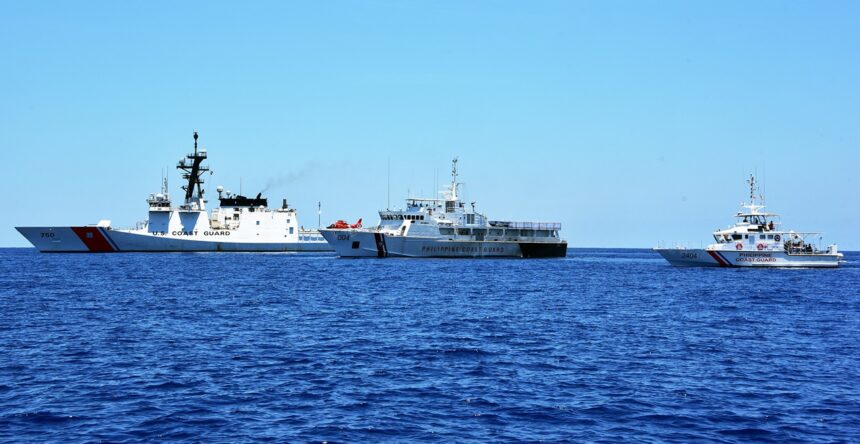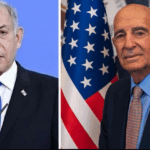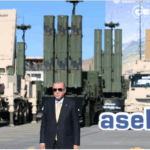Summary by Geopolist | Istanbul Center for Geopolitics:
The article details the Philippines’ multifaceted strategy in the South China Sea, emphasizing President Ferdinand Marcos Jr.’s approach:
- Unilateral Actions: Conducting diplomatic protests, modernizing the military, increasing transparency, and legislative measures.
- Bilateral Engagements: Enhancing defense cooperation with allies such as the US and Japan.
- Minilateral Collaborations: Participating in regional groupings with countries like Australia, Japan, and the US.
- Multilateral Efforts: Advocating for a legally binding Code of Conduct within ASEAN.
Challenges include China’s aggressive actions and internal political dynamics. For more details, read the full article here below.
Tensions in the South China Sea between the Philippines and China have increased, causing Philippine President Ferdinand Marcos Jr. to adopt a multi-pronged South China Sea (SCS) strategy. It is both a continuation and an expansion of his predecessors’ approaches to the SCS, and require strong external support.
The strategy, which forms a substantial part of Philippine foreign policy, is comprehensively being demonstrated at the unilateral, bilateral, minilateral, and multilateral levels. More often than not, its many components have been siloed by observers in their commentary, rather than examining it from its larger agenda.
Unilaterally, besides the 150 diplomatic protests filed, and frequent invocation of the 2016 South China Sea Arbitral Award, the Marcos Jr. administration has taken informational, military, bureaucratic, legislative, and operational measures to assert Philippine territorial and maritime claims in the SCS. Foremost, and most conspicuous, is the “transparency initiative,” which aims to exact reputational costs on China by exposing–through local and international media–the excesses of China’s actions. The intention here is to bring global pressure to bear, and change China’s behavior and refrain from obstructing Philippine rotation and resupply (RORE) missions, fishing access, and marine scientific research activities.
The transparency initiative has also enabled the Philippine government to shape the information environment and engage in cognitive warfare by neutralising misinformation and disinformation among Philippine narratives. As a result, domestic support has been galvanised and public opinion has rallied behind government and state policy. Noticeably, there is now a default and coordinated diplomatic response by Western powers and traditional Philippine security partners in calling out China whenever it has run-ins with the Philippines in the SCS. Securing congressional support for the modernisation programs of the Armed Forces of the Philippines (AFP) and the Philippine Coast Guard (PCG) has likewise been forthcoming with policymakers demanding the expedited acquisition of military and maritime assets.
Militarily, the Philippines continues to strengthen its foothold on occupied maritime features in the SCS by building new structures like barracks and health centers. With internal security threats such as communist insurgency and Islamic secessionism largely removed, the AFP with its new modernisation program (Re-Horizon 3) is now more focused on external security. This modernisation is complemented by military exercises such as the multi-service AFP Joint Exercise Dagat-Langit-Lupa (AJEX-DAGITPA), and the Philippine Army’s Combined Arms Training Exercise (CATEX), which underscores the Philippine Army’s shift to territorial defence capability. Legally, the Philippines is in the process of passing laws (i.e., Maritime Zones Act, Archipelagic Sea Lanes Act) that will bolster Philippine sovereignty and sovereign rights in the SCS, and safeguard national security (Revised Espionage Act).
Marcos Jr. has also embarked on bureaucratic restructuring by issuing an Executive Order to put in place a “central body-in-charge” of consolidating policies, strategies, and governance frameworks for the Philippines’ maritime security and maritime domain awareness. Operationally, there have been increased sovereignty patrols and escort missions by the PCG and provision of oil subsidies for Philippine fishermen, courtesy of the Bureau of Fisheries and Aquatic Resources.
Bilaterally, the Philippines, as part of preventive diplomacy, continues to engage and seek guardrails in its relations with China through various channels like the Bilateral Consultation Mechanism. Concurrently, the Philippines is institutionalising security cooperation with numerous security partners through defence cooperation agreements and capacity-building programs, and is prioritising relations with the US. The Visiting Forces Agreement (VFA) has become a template that has been floated with countries such as France, Canada, New Zealand, and Japan (Reciprocal Access Agreement). And the Philippines has notably been designated as a priority recipient of Japan’s pioneering Official Security Assistance.
However, cooperation with the US stands out as key for the Philippines’ defence. Besides the expansion of the number of Enhanced Defense Cooperation Agreement (EDCA) sites last year, which marked Manila’s open desire to accommodate more US military presence, alliance cooperation is being modernised and deepened through Washington’s Security Sector Assistance Roadmap and the proposed General Security of Military Information Agreement. The US is also stepping up its Foreign Military Financing assistance to the Philippines to the tune of US$2.5 billion with the proposed bipartisan Philippines Enhanced Resilience Act of 2024. The scale and scope of military exercises between the Philippines and the US has been intensified with activities such as coastal defence, island retaking, Sinking Exercises (SINKEX), and joint air force exercises (Cope Thunder), among others. If Rodrigo Duterte had visited China five times throughout his term in office, Marcos has visited the US four times in his first two years.
Minilaterally, the Philippines, cognizant of ASEAN’s limitations, has been working with offshore balancers by becoming a party to the Japan-Philippines-US Trilateral Summit and the “Second Quad” or “SQUAD” grouping comprised of Australia, Japan, the Philippines, and the US. Interestingly, economic security has figured highly in these arrangements. Multilaterally, the Philippines still voices its concerns on the SCS in ASEAN and strongly lobbies for the conclusion of a legally binding Code of Conduct (COC). Like the Benigno Aquino III administration, the Marcos administration is contemplating filing another international case against China on grounds of marine environmental destruction. Moreover, previous bilateral military exercises have evolved into Multilateral Maritime Cooperation Activities and Multilateral Maritime Exercises.
Clear power asymmetries with China has caused Manila to deepen external balancing efforts, information campaigns, and legal approaches. Multiple challenges continue to confront the Marcos Jr. administration, however. First, China remains undeterred in the SCS and has only increased its appetite for risk escalation, testing Washington’s “iron clad commitment.” The EDCA sites, Balikatan, joint sails, and other military exercises have given the Philippines a sense of confidence and has enhanced interoperability and force projection, although Beijing’s actions continue to expose their tangentiality.
Second, the rising nationalist sentiments brought about by the transparency initiative has created a shift in public sentiment from animosity towards China to disaffection with the government’s restraint, which has been construed as a sign of weakness as more people demand stronger action than just expositions of Chinese activities and statements of solidarity by other countries. Relatedly, since the transparency initiative needs maximum attention to be effective, it would mean that the SCS will take front and center of bilateral ties with China, which, in turn, could complicate attempts to isolate other policy issue-areas.
Third, the Philippines is in a quandary with its policy choices limited to Manichean bineries. Manila’s diplomatic and legal stance on the one hand, and the leveraging of alliance with the US and defence partnerships on the other, shows that Manila is caught between a reluctance to accept unilateral risk escalation and a willingness to prepare for black-and-white (wartime) scenarios through formal cooperation with like-minded actors. The former signifies aversion to war and the latter indicates dependence, which partly explains why many Filipinos liberally interpret the word “armed attack” in Article 4 of the Mutual Defense Treaty (MDT) with the US. While the absence of “armed attack” does not make the US in breach of its MDT obligations, China’s actions are forcing the alliance to react and be creative, for failure to do so risks making the alliance appear useless.
American scholars argue that China is singling out the Philippines because it is a US ally. Yet, some quarters in the Philippines point to non-US allied countries, as in the case of the 2014 China-Vietnam Oil Rig Incident and the 2020-2021 China-India Border Skirmishes, where short of war operational and tit-for-tat tactical designs were employed that pushed back against and de-escalated tensions with China. In view of this, various non-kinetic and non-combat policy actions have been put forward from joint ROREs with the US to the construction of an oil-rig-like structure on Second Thomas Shoal.
Based on the pattern of incidents in recent months, and on previous aggressive actions by China, Filipinos are bracing for what might come next. It is said that China could soon board the marooned landing ship (BRP Sierra Madre) on Second Thomas Shoal or forcibly tow it away–a red line drawn by the Duterte administration. Certain exogenous and endogenous factors are worth considering for Manila going forward. Externally, the upcoming elections in the US are contingencies the Philippines should gear up for and hedge against. The changing preferential views of the US and China in other ASEAN capitals–owing to China’s charm offensive, wedge strategy, and US global reputation–could be a litmus test for how Philippine alignment with the US is perceived and, concomitantly, the support that the Philippines could get on the SCS from its neighbors.
Internally, whether or not Marcos Jr.’s declining approval ratings will impact the legitimacy of his foreign policy posture remains to be seen. Under Duterte, unpopular China policies were offset by his popularity and that of his domestic agenda. The coming days, months, and years will be a game of attrition and strategic patience.
Aaron Jed Rabena is Professorial Lecturer at the Asian Center in the University of the Philippines.
This article is published under a Creative Commons License and may be republished with attribution.







